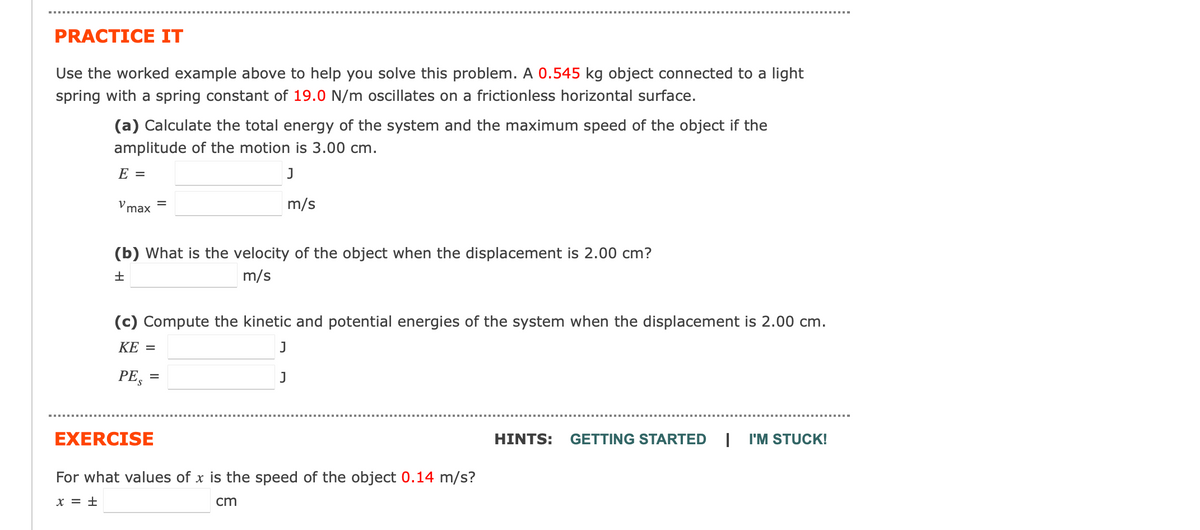Use the worked example above to help you solve this problem. A 0.545 kg object connected to a light spring with a spring constant of 19.0 N/m oscillates on a frictionless horizontal surface. (a) Calculate the total energy of the system and the maximum speed of the object if the amplitude of the motion is 3.00 cm. E = "max = J m/s (b) What is the velocity of the object when the displacement is 2.00 cm? ± m/s (c) Compute the kinetic and potential energies of the system when the displacement is 2.00 cm. KE = J PE, = J EXERCISE HINTS: GETTING STARTED I'M STUCK!
Simple harmonic motion
Simple harmonic motion is a type of periodic motion in which an object undergoes oscillatory motion. The restoring force exerted by the object exhibiting SHM is proportional to the displacement from the equilibrium position. The force is directed towards the mean position. We see many examples of SHM around us, common ones are the motion of a pendulum, spring and vibration of strings in musical instruments, and so on.
Simple Pendulum
A simple pendulum comprises a heavy mass (called bob) attached to one end of the weightless and flexible string.
Oscillation
In Physics, oscillation means a repetitive motion that happens in a variation with respect to time. There is usually a central value, where the object would be at rest. Additionally, there are two or more positions between which the repetitive motion takes place. In mathematics, oscillations can also be described as vibrations. The most common examples of oscillation that is seen in daily lives include the alternating current (AC) or the motion of a moving pendulum.

![STRATEGY The total energy of the system can be found most easily at the amplitude x = A, where the
kinetic energy is zero. There, the potential energy alone is equal to the total energy. Conservation of
energy then yields the speed at x = 0. For part (b), obtain the velocity by substituting the given value of x
into the time independent velocity equation. Using this result, the kinetic energy asked for in part (c) can
be found by substitution, as can the potential energy.
SOLUTION
(A) Calculate the total energy and maximum speed if the amplitude is 3.00 cm.
E = KE + PEg + PES
= 0 + 0 + ¹2kA² = ½(20.0 N/m)(3.00 x 10-² m)²
= 9.00 × 10-³ J
Substitute x = A = 3.00 cm and
k = 20.0 N/m into the equation for the
total mechanical energy E.
Use conservation of energy with x; = A
and
xf
= 0 to compute the speed of the
object at the origin.
Substitute known values.
(KE + PE + PE§); = (KE + PEg + PEs) f
0 + 0 + 1₂kA² = 1/2mv²_
1/2mv²
Substitute into the equation for spring
potential energy.
Vmax
max
V =
= 9.00 × 10-³ J
(B) Compute the velocity of the object when the displacement is 2.00 cm.
v = ± √k/m(A² – x²)
20.0 N/m
0.500 kg
(
= ±0.141 m/s
±
1.80 x 10-² J
0.500 kg
max
= 1⁄2kx²
+0+0
PES
= 4.00 × 10-³ J
0.190 m/s
(C) Compute the kinetic and potential energies when the displacement is 2.00 cm.
Substitute into the equation for kinetic
energy.
=
[(0.0300 m)² (0.0200 m
-
KE = 1/2mv² = 1/2(0.500 kg)(0.141 m/s)² = 4.97 × 10-³ J
²])
(20.0 N/m) (2.00 x 10-² m)²
½](/v2/_next/image?url=https%3A%2F%2Fcontent.bartleby.com%2Fqna-images%2Fquestion%2F5630fc0f-1d39-4405-9289-17dd8428ca98%2Ff1625a31-0fca-48b5-b36f-f248f7566144%2Fs2vxwxn_processed.png&w=3840&q=75)
Trending now
This is a popular solution!
Step by step
Solved in 4 steps







